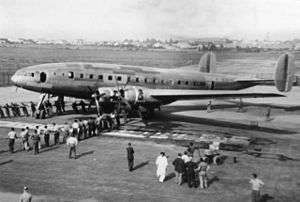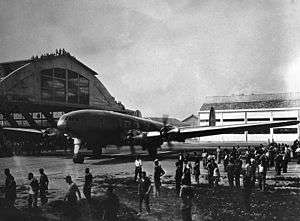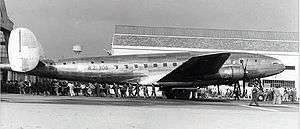Breda-Zappata BZ.308
| B.Z.308 | |
|---|---|
 | |
| Role | Four-engined airliner |
| Manufacturer | Breda |
| Designer | Filippo Zappata |
| First flight | 1948 |
| Introduction | 1949 |
| Primary user | Italian Air Force |
| Number built | 1 |
|
| |


The Breda-Zappata B.Z.308 was an Italian four-engined airliner produced by Breda.
Design and development
The B.Z.308 was a four-engined civil transport developed in the late 1940s for operation over both European and transatlantic routes. A large low-wing monoplane of all-metal construction, it was powered by four Bristol Centaurus radial engines driving five-bladed propellers. It had a large tailplane with endplate fins and rudders, and had retractable landing gear. The fuselage, oval in cross-section, accommodated a flight crew of five and 55 passengers in two cabins; a high-density model was planned with seats for 80.
Construction began during 1946, under aircraft designer Filippo Zappata at Breda's Sesto San Giovanni works. The Allied Commission halted the work, which was not resumed until January 1947. Further delays in the delivery of Bristol Centaurus engines delayed the first flight, which was on 27 August 1948, piloted by Mario Stoppani. Although flight testing went well, the project was abandoned as a result of financial problems, anticipated competition from American airliners in the postwar market, and pressure (under the Marshall plan) to close down Breda’s aeronautical section. Breda subsequently stopped producing aircraft entirely.
Operational history
The prototype B.Z.308 was acquired by the Italian Air Force in 1949 as a transport aircraft (MM61802).
Despite orders in 1950 from India, Argentina and Persia, only the prototype was built, allegedly also due to pressure from the allies for Italy to refrain from competing in civilian aircraft manufacture after the war.
On 27 August 1948 the Bz 308 made its maiden flight, in front of civil and military authorities, politicians and the Italian President.
The prototype, which passed to the Italian Air Force in 1950 was used to fly between Rome and Mogadishu until on February 21, 1954, when it damaged beyond repair by a collision with a cement truck, it was abandoned in a field in Somalia before being broken up.[1]
It was also the first Italian transatlantic aircraft, and the first aircraft to fly into the new Malpensa airport in 1948.
The aircraft is also clearly visible in the airport scene of the film Roman Holiday.
Operators
Specifications (B.Z.308)
Data from Jane's All The World's Aircraft 1951–52[2]
General characteristics
- Crew: five (two pilots, flight engineer, navigator and radio operator)
- Capacity: 54 passengers
- Length: 33.52 m (110 ft 0 in)
- Wingspan: 42.1 m (138 ft 1 in)
- Height: 7.15 m (23 ft 5 in)
- Wing area: 208 m2 (2,240 sq ft)
- Aspect ratio: 8.55:1
- Empty weight: 27,500 kg (60,627 lb)
- Max takeoff weight: 46,500 kg (102,515 lb)
- Fuel capacity: 18,000 L (4,800 US gal; 4,000 imp gal)
- Powerplant: 4 × Bristol Centaurus 568 18-cylinder air-cooled radial engines, 1,900 kW (2,500 hp) each
Performance
- Maximum speed: 573 km/h (356 mph; 309 kn)
- Cruising speed: 441 km/h (274 mph; 238 kn) at 4,300 m (14,100 ft)
- Stall speed: 135 km/h (84 mph; 73 kn)
- Range: 7,700 km (4,785 mi; 4,158 nmi)
- Service ceiling: 8,000 m (26,247 ft)
References
- ↑ "Breda-Zappata BZ.308" Aviation Safety
- ↑ Bridgman 1951, p. 153c.
- Bridgman, Leonard (1951). Jane's All The World's Aircraft 1951–52. London: Sampson Low, Marston & Company, Ltd.
- The Illustrated Encyclopedia of Aircraft (Part Work 1982-1985). Orbis Publishing.
External links
| Wikimedia Commons has media related to Breda-Zappata BZ.308. |
[For an artist's impression see http://wp.scn.ru/en/ww3/t/1079/60/0/1]
[For a photograph see https://web.archive.org/web/20060116050630/http://www.aerei-italiani.net:80/Sfondi/Sfondo_13.jpg]
[For an Italian site detailing the history of the BZ.308, see: https://web.archive.org/web/20070327185246/http://www.url.it:80/muvi/mostre/08mostra/mostrasx.htm]